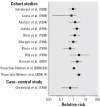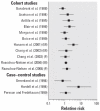Trichloroethylene cancer epidemiology: a consideration of select issues
- PMID: 16966107
- PMCID: PMC1570052
- DOI: 10.1289/ehp.8949
Trichloroethylene cancer epidemiology: a consideration of select issues
Abstract
A large body of epidemiologic evidence exists for exploring causal associations between cancer and trichloroethylene (TCE) exposure. The U.S. Environmental Protection Agency 2001 draft TCE health risk assessment concluded that epidemiologic studies, on the whole, support associations between TCE exposure and excess risk of kidney cancer, liver cancer, and lymphomas, and, to a lesser extent, cervical cancer and prostate cancer. As part of a mini-monograph on key issues in the health risk assessment of TCE, this article reviews recently published scientific literature examining cancer and TCE exposure and identifies four issues that are key to interpreting the larger body of epidemiologic evidence: a) relative sensitivity of cancer incidence and mortality data ; b) different classifications of lymphomas, including non-Hodgkin lymphoma ; c) differences in data and methods for assigning TCE exposure status ; and d) different methods employed for causal inferences, including statistical or meta-analysis approaches. The recent epidemiologic studies substantially expand the epidemiologic database, with seven new studies available on kidney cancer and somewhat fewer studies available that examine possible associations at other sites. Overall, recently published studies appear to provide further support for the kidney, liver, and lymphatic systems as targets of TCE toxicity, suggesting, as do previous studies, modestly elevated (typically 1.5-2.0) site-specific relative risks, given exposure conditions in these studies. However, a number of challenging issues need to be considered before drawing causal conclusions about TCE exposure and cancer from these data.
Figures




References
-
- Ahrens C, Altman N, Casella G, Eaton M, Hwang JTG, Staudenmayer J, et al. Leukemia clusters in upstate New York: how adding covariates changes the story. Environmetrics. 2001;12:659–672.
-
- Aickin M. Bayes without priors. J Clin Epidemiol. 2004;57:4–13. - PubMed
-
- Aickin M, Chapin CA, Flood TJ, Englender SJ, Caldwell GG. Assessment of the spatial occurrence of childhood leukaemia mortality using standardized rate ratios with a simple linear Poisson model. Int J Epidemiol. 1992;21:649–655. - PubMed
-
- Anttila A, Pukkala E, Sallmen M, Hernberg S, Hemminki K. Cancer incidence among Finnish workers exposed to halogenated hydrocarbons. J Occup Environ Med. 1995;37:797–806. - PubMed
-
- Axelson O, Selden A, Andersson K, Hogstedt C. Updated and expanded Swedish cohort study of trichloroethylene and cancer risk. J Occup Med. 1994;36:556–562. - PubMed
Publication types
MeSH terms
Substances
LinkOut - more resources
Full Text Sources
Other Literature Sources
Research Materials

